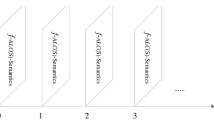Abstract
Description logics (DLs) are widely employed in recent semantic web application systems. However, classical description logics are limited when dealing with imprecise concepts and roles, thus providing the motivation for this work. In this paper, we present a type-2 fuzzy attributive concept language with complements (ALC) and provide its knowledge representation and reasoning algorithms. We also propose type-2 fuzzy web ontology language (OWL) to build a fuzzy ontology based on type-2 fuzzy ALC and analyze the soundness, completeness, and complexity of the reasoning algorithms. Compared to type-1 fuzzy ALC, type-2 fuzzy ALC can describe imprecise knowledge more meticulously by using the membership degree interval. We implement a semantic search engine based on type-2 fuzzy ALC and carry out experiments on real data to test its performance. The results show that the type-2 fuzzy ALC can improve the precision and increase the number of relevant hits for imprecise information searches.
Similar content being viewed by others
Explore related subjects
Discover the latest articles and news from researchers in related subjects, suggested using machine learning.References
Stix G. The mice that warred: natural selection. Scientific American, 2001, 284(6): 34–35
Guha R, McCool R, Miller E. Semantic search. In: Proceeding of 12th International World Wide Web Conference. 2003, 700–709
Baader F, Calvanese D, McGuinness D L, Patel-Schneider P. The Description Logic Handbook: Theory, Implementation, and Applications. London: Cambridge University Press, 2003, 47–100
Calvanese D, Lenzerini M, Nardi D. Unifying class-based representation formalisms. Journal of Artificial Intelligence Research, 1999, 11(2): 199–240
Schmidt-Schaubß M, Smolka G. Attributive concept descriptions with complements. Artificial Intelligence, 1991, 48(1): 1–26
Heflin J D. Towards the semantic web: knowledge representation in a dynamic distributed environment. Dissertation for the Doctoral Degree. College Park: University of Maryland, 2001
Heflin J, Hendler J. Searching the web with shoe. In: Proceedings of AAAI-2000 Workshop on AI for Web Search. 2000, 35–40
Guha R, McCool R. TAP: A semantic web test-bed. Journal ofWeb Semantics, 2003, 1(1): 81–87
Ding L, Finin T, Joshi A, Pan R, Cost R S, Peng Y, Reddivari P, Doshi V, Sachs J. Swoogle: a search and metadata engine for the semantic web. In: Proceedings of 13th ACM International Conference on Information and Knowledge Management. 2004, 294–303
Finin T W, Mayfield J, Joshi A, Cost R S, Fink C. Information retrieval and the semantic web. In: Proceedings of 38th Hawaii International Conference on System Sciences. 2005
Manola F, Miller E. Resource Description Framework (RDF), W3C Recommendation. W3C, 2004, http://www.w3.org/RDF/
McGuinness D L, van Harmelen F. OWLWeb Ontology Language Overview, W3C Recommendation. W3C, 2004, http://www.w3.org/TR/owl-features/
Brockmans S, Colomb R M, Haase P, Kendall E F, Wallace E K, Welty C, Xie G T. A model driven approach for building OWL DL and OWL full ontologies. In: Proceeding of 5th International Semantic Web Conference. 2006, 187–200
Zadeh L A. Fuzzy sets. Information and Control, 1965, 8(3): 338–353
Meghini C, Sebastiani F, Straccia U. Reasoning about the form and content for multimedia objects. In: Proceedings of AAAI 1997 Spring Symposium on Intelligent Integration and Use of Text, Image, Video and Audio. 1997, 89–94
Straccia U. Reasoning within fuzzy description logics. Journal of Artificial Intelligence Research, 2001, 14: 137–166
Straccia U. Description logics with fuzzy concrete domains. In: Proceedings of 21st Conference in Uncertainty in Artificial Intelligence. 2005, 559–567
Straccia U. Towards a fuzzy description logic for the semantic web. In: Proceedings of the 1st Fuzzy Logic and the Semantic Web Workshop, Marseille, 2005, 3–18
Li Y, Lu J, Xu B, Kang D, Jiang J. A fuzzy extension of description logic ALCH. In: Proceedings of 4th Mexican International Conference on Artificial Intelligence. 2005, 152–161
Li Y, Xu B, Lu J, Kang D, Xu J. Reasoning technique for extended fuzzy description logics. In: Proceedings of 17th IEEE International Conference on Tools with Artificial Intelligence. 2005, 665–666
Li Y, Xu B, Lu J, Kang D, Wang P. A family of extended fuzzy description logics. In: Proceedings of 29th Annual International Computer Software and Applications Conference. 2005, 221–226
Jiang Y, Tang Y, Wang J, Deng P, Tang S. Expressive fuzzy description logics over lattices. Knowledge-Based Systems, 2010, 23(2): 150–161
Jiang Y, Tang Y, Wang J, Tang S. Reasoning within intuitionistic fuzzy rough description logics. Information Sciences, 2009, 179(14): 2362–2378
Hajek P. Making fuzzy description logic more general. Fuzzy Sets and Systems, 2005, 154(1): 1–15
Jin H, Ning X, Jia W, Wu H, Lu G. Combining weights with fuzziness for intelligent semantic web search. Knowledge-Based Systems, 2008, 21(7): 655–665
Li R, Sun X, Lu Z, Wen K, Li Y. Towards a type-2 fuzzy description logic for semantic search engine. In: Proceedings of joint conference of 9th Asia-Pacific Web Conference and 8th International Conference on Web-Age Information Management. 2007, 805–812
De Giacomo G, Lenzerini M. TBox and ABox reasoning in expressive description logics. In: Proceedings of 5th International Conference on the Principles of Knowledge Representation and Reasoning. 1996, 316–327
The Protégé Ontology Editor and Knowledge Acquisition System. http://protege.stanford.edu/
Author information
Authors and Affiliations
Corresponding author
Rights and permissions
About this article
Cite this article
Li, R., Wen, K., Gu, X. et al. Type-2 fuzzy description logic. Front. Comput. Sci. China 5, 205–215 (2011). https://doi.org/10.1007/s11704-011-0109-8
Received:
Accepted:
Published:
Issue Date:
DOI: https://doi.org/10.1007/s11704-011-0109-8




